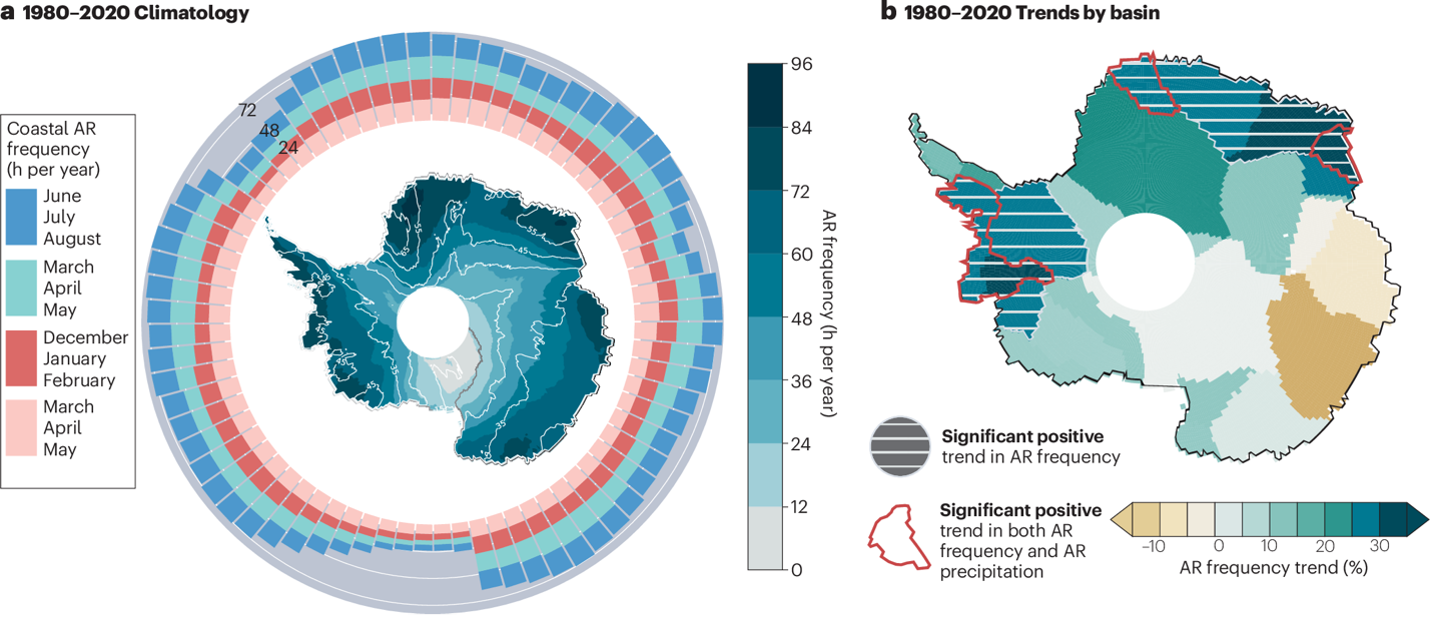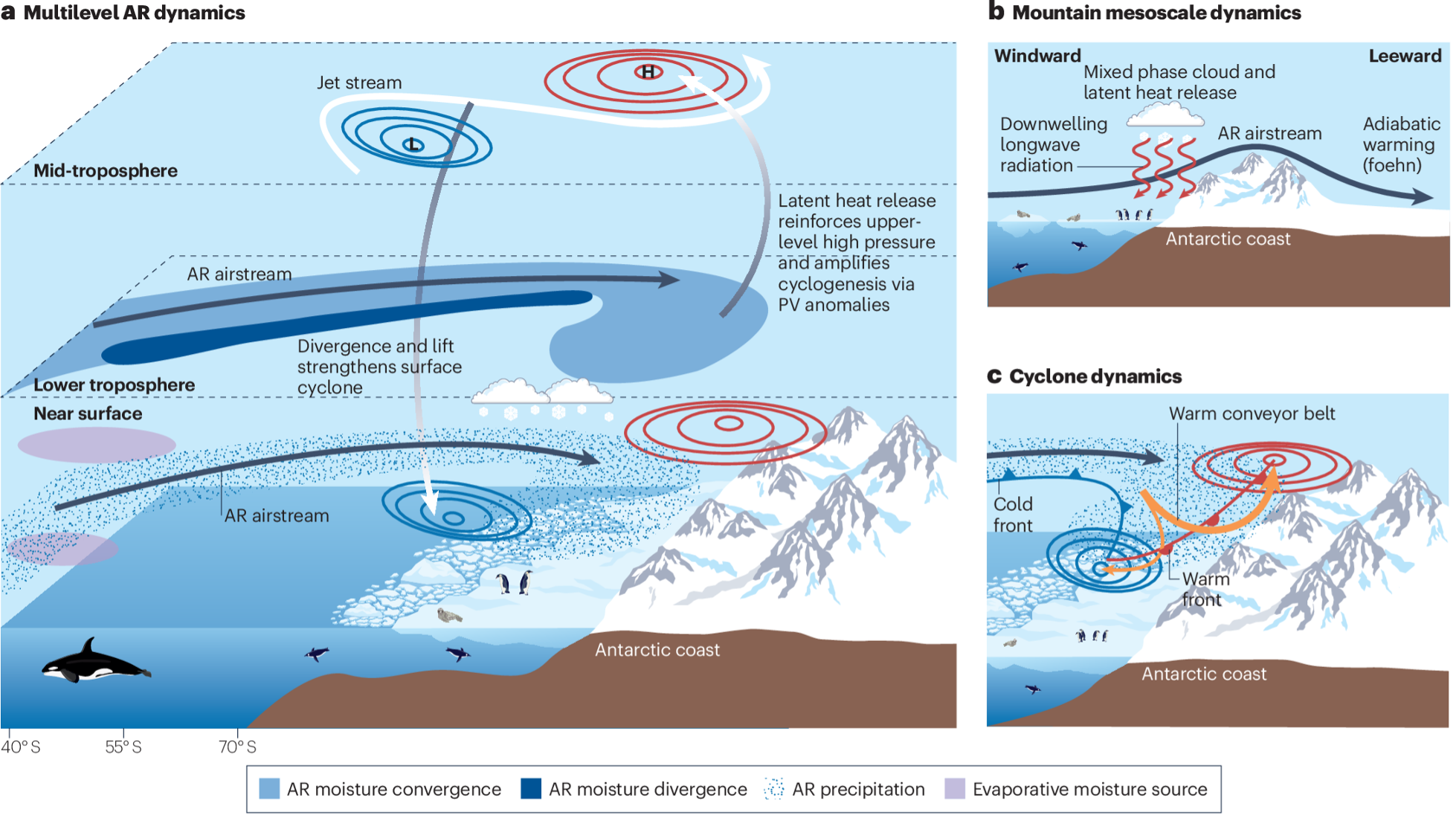CW3E Publication Notice
Atmospheric Rivers in Antarctica
April 15, 2025
A review paper titled “Atmospheric Rivers in Antarctica” was recently published in Nature Reviews Earth & Environment. The study was co-led by Jonathan D. Wille (ETH), Vincent Favier (CNRS), and Irina V. Gorodetskaya (CIIMAR), with contributions from CW3E scientists Xun (Jerry) Zou and Zhenhai Zhang. This international collaboration provides a comprehensive overview of current research on Antarctic atmospheric rivers (ARs). Moreover, this study further expands CW3E’s research on ARs to Antarctica, focusing on how ARs influence extreme weather events and climate feedback processes at high latitudes, including AR impacts on future sea level rise. Antarctic ARs, a form of extreme weather, transport moisture and heat from lower latitudes to the Antarctic continent. While present-day AR events generally contribute positively to the Antarctic ice-sheet mass balance by producing heavy snowfall, they can also trigger sea ice and coastal ice sheet melt and destabilize ice shelves (Figure 1).
Figure 1. (a) Atmospheric river (AR) frequency (h per year, 1980–2020; teal shading) derived from the algorithm and MERRA-2 (Modern-Era Retrospective Analysis for Research and Applications, version 2) reanalysis. Interannual variability is shown in white contours (h per year). Coastal (based on ice sheet and shelves) AR frequency is shown by longitude and grouped by season. (b) Relative change in AR frequency (%) by individual glacier basin from 1980 to 2020 is shown with shading, also based on the MERRA-2 reanalysis. Hatching indicates a linear fit of AR frequency (horizontal) or AR precipitation (vertical) per basin from 1980 to 2020 that has a P value <0.05. AR precipitation trend values are not shown. Despite being rare events, positive trends in AR frequency are responsible for increased snowfall in West Antarctica and Queen Maud Land during the 1980–2020 period. Figure 2 from Wille et al. (2025).
In this review, we investigate the life cycle, atmospheric dynamics (Figure 2), and impacts of Antarctic ARs to better understand their overall influence on the ice-sheet mass balance. Antarctic ARs are typically linked to high-amplitude pressure couplets and often form within Rossby waves generated by tropical convection. Although ARs reaching Antarctica are relatively infrequent — occurring on average about three days per year at any given location — they are responsible for 50–70% of extreme snowfall events in East Antarctica since the 1980s. Despite their role in delivering heavy snowfall, ARs can also drive widespread surface melting, contributing to the collapse of ice shelves, such as Larsen A in 1995 and Larsen B in 2002. As climate change amplifies atmospheric water vapor, ARs are expected to intensify, raising critical questions about how these changes will reshape the delicate balance between snowfall and melt, alter ice-sheet stability, and affect future sea-level rise. Addressing these uncertainties will be key for understanding Antarctica’s evolving role in the global climate system.
Figure 2. (a) Multilevel atmospheric river (AR) dynamics, from the surface, through to the lower troposphere and mid-troposphere. Mid-latitude sources of moisture are transported towards the polar latitudes by an AR (grey arrow), resulting in latent heat release of AR moisture. When the latent heat release occurs, it amplifies the polar jet stream (white arrow) and cyclogenesis via potential vorticity (PV) anomalies. (b) Mountainous meso-scale dynamics typically observed in coastal regions such as the Antarctic Peninsula, focusing on thermodynamic processes. Mixed-phase clouds along the windward coastline heat the surface through downwelling longwave radiation (red arrows). When the AR airstream crosses mountainous terrain, it descends and warms adiabatically creating a foehn wind on the leeward side. (c) Cyclone (synoptic-scale) dynamics demonstrating the pathway of the AR airstream as it lifted isentropically in the warm conveyer belt (orange arrows) over the warm front and eventually reaches the anticyclone (high-pressure area), causing the cyclone to intensify. ARs, through the poleward transport of moisture and heat, substantially alter the dynamics and thermodynamics of Antarctic weather patterns when reaching the cold, and sometimes mountainous terrain, along the Antarctic coastline. Figure 1 from Wille et al. (2025).
Although progress has been made in understanding Antarctic ARs, key gaps remain. Ongoing research aims to identify the various tropical forcing patterns necessary for the initial tropical moisture export and Rossby wave amplification that directs moisture transportation. Once moisture reaches the Antarctic Ice Sheet, its influence on mesoscale cyclonic activity remains uncertain. High-resolution, kilometer-scale models are critical for resolving how moisture transport within warm conveyor belts affects cyclone intensity and AR impacts. Additionally, uncertainties in polar AR detection techniques are crucial for better understanding AR impacts. Detecting AR signals in ice core records prior to the reanalysis period (1979 onward) could allow for climate reconstructions of Antarctic ARs over a longer timeframe. The critical question ahead is how the balance between the positive and negative impacts of ARs on ice-sheet mass balance will shift with climate change, both in the near and long term. Addressing this in climate models is essential for understanding how rare but impactful events affect AIS stability and for refining projections of future sea-level rise.
Wille, J. D., Favier, V., Gorodetskaya, I. V., Agosta, C., Baiman, R., Barrett, J. E., Barthelemy, L., Boza, B., Bozkurt, D., Casado, M., Chyhareva, A., Clem, K. R., Codron, F., Datta, R. T., Durán-Alarcón, C., Francis, D., Hoffman, A., Kolbe, M., Krakovska, S., Linscott, G., Maclennan, M. L., Mattingly, K. S., Mu, Y., Pohl, B., Leroy-Dos Santos, C., Shields, C., Toker, E., Winters, A. C., Yin, Z., Zou, X., Zhang, C., & Zhang, Z. (2025). Atmospheric rivers in Antarctica. Nature Reviews Earth & Environment, 6, 178-192. https://doi.org/10.1038/s43017-024-00638-7


